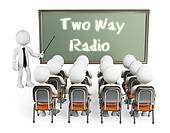
A two-way radio is simply a radio that can both transmit and receive (a transceiver). In broader terms, most voice wireless communications systems, including cellular system, fall into two-way radio definition. For this series ‘Two-Way Radio Explained,’ two-way radio refers to a radio system mainly used for group call communication. This two-way radio system is also known as Professional Mobile Radio (PMR), Land Mobile Radio (LMR), Private Mobile Radio (PMR) and Public Access Mobile Radio (PAMR) system. Portable two-way radios are often called walkie-talkies or handy-talkies. Two-way radios are also available in mobile and base configurations as well as utilizing radio network infrastructure.
A two-way radio is typically equipped with a Push-To-Talk ‘PTT’ button to activate the transmitter. User just simply presses the PTT button and can immediately start to talk. User releases the PTT button to listen to others.
Two-way radio can ‘talk’ directly to other radios or use radio network infrastructure. A direct talk among radios (usually also known as direct more operation, talk around mode) has limited range due to limitation of radio power. To overcome this limitation, a radio network infrastructure can be utilized to extend communication range.
Category: LEARNING CENTRE
Tags: